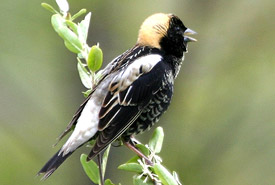Île aux Grues - The upper marshes

Bobolink (Photo by Bill Hubick)
In the middle of the St. Lawrence River, approximately 80 kilometres east of Quebec City, lies Île aux Grues. It is recognized as a high biodiversity site in the province. More than 200 bird species nest or use the habitats found here during migration.
Île aux Grues is connected to Île aux Oies by a tidal flat: the upper marshes (haut marais). This strip of land is subject to flooding caused by the river’s high tide. It is designated as a Waterfowl Gathering Area, under the Regulation Respecting Wildlife Habitats of the Government of Quebec. Among the many birds that inhabit Île aux Grues, some are designated at risk or of special concern in Quebec and Canada: bobolink, Nelson’s sharp-tailed sparrow, short-eared owl and yellow rail. The upper marshes are also preferred hunting grounds for many birds of prey, including peregrine falcon.
The Nature Conservancy of Canada (NCC) conserves 170 hectares (421 acres) on the island, including the Jean-Paul-Riopelle Nature Reserve at Pointe aux Pins and the upper marshes at the opposite end. The meadows on these NCC-protected sites feature diverse plants. Victorin’s gentian, a plant species designated as threatened in Quebec and Canada, grows here. Its habitat is limited to this portion of the St. Lawrence River. Here, the fresh water of the river mixes with the salt water of the ocean and is referred to as “brackish.”
Île aux Grues is located in the heart of the St. Lawrence River Estuary. NCC is involved in protecting important marshes and riparian forests to ensure the survival of species that depend on the habitats in this vast natural area.
The upper marshes: a gem to discover!
Did you know that you can visit this hidden gem via a free ferry service? By collaborating with our partners in the community, NCC has developed trails and viewing platforms on the upper marshes so you can take in the picturesque scenery while protecting this fragile ecosystem. See the wonders of this habitat on video:
NCC is proud to have received an award for conserving and enhancing accessibility to the landscape in the upper marshes of Île aux Grues awarded by the Regional County Municipalities of Montmagny as part of the 2022 edition of the Prix du Patrimoine (heritage awards).
Fighting an invasive species : phragmites
There is a marked presence of phragmites, an invasive species, in the upper marshes, which poses a significant threat to wetlands. Find out how we're working with partners to control phragmites on this island.
Acknowledgements
This project, implemented by NCC, was made possible thanks to the valuable contribution of our generous partners:









Private donors also contributed, including Pierre Lamothe and members of the Club des ornithologues de Québec. Many local partners collaborated in this project, including MRC de Montmagny, the municipality of Saint-Antoine-de-l’Isle-aux-Grues, Comité ZIP du Sud-de-l’Estuaire and Université Laval.
NCC thanks all our donors and partners who have made it possible to expand the protected area on Île aux Grues, helping to ensure the survival of species that depend on its precious habitats.
Learn more
The yellow rail and short-eared owl: two threatened species on Isle-aux-Grues




